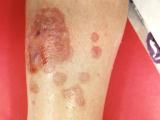A study today in Morbidity and Mortality Weekly Report suggests fungal infections that can cause severe respiratory illness and even death were underdiagnosed and underreported during the first years of the COVID-19 pandemic in the United States.
Signs, symptoms mimic other infections
Coccidioidomycosis, histoplasmosis, and blastomycosis, are all fungal diseases that can affect the lower reparatory tract and result in illnesses that mimic pneumonias caused by more commonly known bacteria and viruses. While they most often cause mild to moderate illness, some infections of the fungi, which are found in soil and water, can lead to severe disseminated illness and death.
Coccidioidomycosis primarily occurs in the Southwest, and histoplasmosis and blastomycosis are more commonly acquired in central and eastern states, the authors wrote. People become sickened after inhaling spores.
Even before COVID-19, diagnosis was challenging, but the pandemic made it even more so.
"Clinical signs and symptoms commonly resemble those of other respiratory infections, including COVID-19 and bacterial or viral community-acquired pneumonia, and laboratory tests might be difficult to access and interpret," the authors wrote.
Clinical signs and symptoms commonly resemble those of other respiratory infections.
The study analyzed diagnoses from 2019, 2020, and 2021 to understand how and if the pandemic affected fungal infection reporting. Case-level coccidioidomycosis data from 26 states were included, along with histoplasmosis data from 13 states, and blastomycosis information from 5 states.
Seasonality patterns changed in 2020
A total of 59,655 coccidioidomycosis cases were reported in the 3 years: In 2019, 20,061 cases; in 2020, 19,284 cases; and in 2021, 20,320 cases. A total of 3,595 histoplasmosis cases were reported (1,124; 1,012; 1,459), and 719 blastomycosis cases (240; 238; 241).
The decrease in cases in 2020 for coccidioidomycosis and blastomycosis is contrasted with a sharp increase in histoplasmosis cases in 2021, the authors said. The decrease in cases of fungal infection might have been related to mask-wearing and other pandemic behaviors, including limited travel to regions where the fungi live, while the increase in histoplasmosis could be due to more time spent outside in 2021.
During 2020, fewer cases of each disease occurred in the spring than in other seasons, the authors said, suggesting seasonality disruption caused by the start of the pandemic. Cases were seasonally distributed more evenly throughout 2019 and 2021.
All case-fatality rates (CFR) remained steady across the 3-year study period, except for blastomycosis, which nearly doubled, from 9% in 2019 and 2020 to 17% in 2021. The typical CFR for blastomycosis is 8% to 10%, the authors said.
"Increased awareness is needed to improve prompt diagnosis and treatment of coccidioidomycosis, histoplasmosis, and blastomycosis, particularly during periods of increased incidence of other respiratory diseases," the authors concluded. "Standardized diagnostic guidance and informational resources for pan-respiratory testing, including fungal diseases, are needed and could be incorporated into broader respiratory disease awareness and preparedness efforts."




















